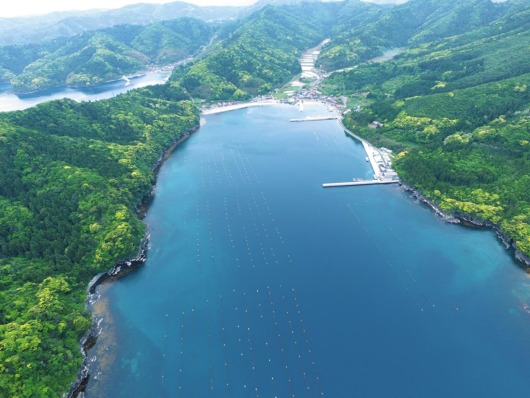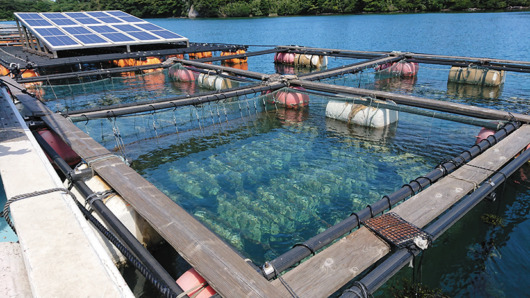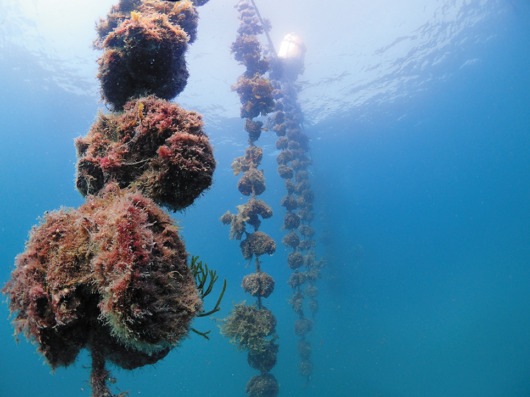Oyster Wine Contest 2021 Special Sponsor “Iwagaki Haruka”. Aiming to be the best rock oyster in Japan.

For even higher levels of safety and reliability. A pioneer in rock oyster farming continues to progress.

The word "terroir" is often used to describe wine.
The term "terroir" encompasses the background, climate, geography, and soil in which the product is grown.
The word "terroir" also includes the temperament of the people involved in the production of the product.
"Iwagaki Haruka" is the result of this unique natural terroir.
At a time when rock oysters were natural products, no one had ever thought of cultivating them.
The reason behind the taste that makes people say, "Delicious!” there is a terroir and a story behind the taste that moves you.
The hometown of "Iwagaki Haruka". Ama Town, Oki Island, Shimane Prefecture.

Oki Island, located about 60 km off the coast of the Sea of Japan in Shimane Prefecture, has been known since ancient times as "Miketsukuni," a country that contributes marine products to the Imperial Family and the Imperial Court.
Even today, the island maintains its beautiful natural environment and produces a wide variety of marine and agricultural products.
Oki Island consists of more than 180 islands, large and small, and "Iwagaki Haruka" is a specialty of Ama Town, located on Nakanoshima, one of the three islands of Shimamae.
At first, the young shellfish are raised in the calm inland sea of Ama, but once they have grown to a certain extent, they are raised in the open sea, far away from rivers.
The open sea is ideal for avoiding the risk of norovirus and other germs because it is not affected by domestic wastewater.
However, it also has the risk of rough waves, many natural enemies, and low nutrient levels, so it takes a long time to grow.
In the first place, "Iwagaki Haruka" oysters are cultivated in waters that have been designated by the public health center for the shipment of oysters for raw consumption, so safety and security are already guaranteed. Furthermore, "Iwagaki Haruka" has established its own safety and hygiene management standards as a brand, and Ama Town itself is promoting "community development that pursues the relationship between the sea and people from all directions.
The town has been working tirelessly to protect the beautiful ocean.
One example is the maintenance of the sewage system.
In Ama Town, the sewerage penetration rate is almost 100%, which is 72.3% in mainland Shimane Prefecture and 75.8% in Hiroshima Prefecture compared to the 2019 data.
The high figures for this small municipality are surprising. The entire town is working together to protect the growing environment of this important product.
All "Iwagaki Haruka" oysters are shipped for raw consumption, and to date, there has not been a single health problem that could be attributed to rock oysters, thanks to this beautiful ocean.
The pioneer in rock oyster cultivation continues to study and develop original research and development.

"Iwagaki Haruka" has been making unceasing efforts to improve its quality.
As a pioneer in rock oyster cultivation, the company is famous in the oyster industry for developing its own cultivation methods and tools.
For example, in the past, it was common to attach young oysters to scallop shells for seedling production. However, "Iwagaki Haruka" has chosen to use flexible resin "trails". This makes it possible for the larvae to grow as a single seed (single oyster) because the larvae can easily become independent of each other, which allows for better nutrition, and also makes it easier to remove the larvae from the nursery.
When cultivating in the open sea, the oysters are fixed in the ideal location on the rope with "Kydelite," which was developed for oyster cultivation, so that each rock oyster can take in enough plankton. In addition, we have succeeded in improving the growth rate of oysters in the open sea by 10 to 20% by generating microbubbles powered by sunlight for six hours a day.
For shipping, the company has established strict standards for a total of 11 items, including the sea area where the fish are raised, inspections, and measures to be taken in case of health problems.
The information, which is strictly controlled from production to processing and distribution, can be easily accessed by simply entering the shipping code on the label into the web page. In recognition of this hospitality, "Iwagaki Haruka" has been awarded the "Delicious Shimane Certification(OISHIMANE Certification)" as the first seafood product to be certified.
Pursuing the true flavor of rock oysters, which are rich but refreshing.

Until now, it has been thought that true oysters are in their prime in the winter, while rock oysters, which have good flesh, are in their prime in the summer.
However, after analyzing the composition of rock oysters throughout the year, the "Iwagaki Haruka" team discovered that glutamic acid is prominent and the flavor component is rich from March to May.
The oysters are certainly more filling in the summer when the sperm and egg cells mature, but the actual aroma and flavor of the oysters are enhanced just before that time.
They found out that the peak of flavor and flesh content of rock oysters are slightly off.
In other words, the best time to eat rock oysters is in spring.
The starting point of "Iwagaki Haruka" was to remove the common sense and preconceived notions and to pursue "truly delicious rock oysters.
For this reason, "Iwagaki Haruka" has narrowed down the period for shipping raw oysters to just three months from March to May, when they are truly delicious.
In the open sea where "Iwagaki Haruka" is grown, the only food available is high-quality phytoplankton. In this environment, the oysters are allowed to grow naturally for two and a half years.
Except for the months of March to May, oysters are shipped frozen using the Cell Alive System (CAS), which prevents damage to cell membranes. Since the top shell is removed for the half-shell type, there is no bother of shelling and thawing is extremely easy. You can enjoy the taste of freshly caught fish at any time of the year.
Creating a sustainable industry on Oki Island! A community-wide approach to sustainability

Oki Island has been offering marine products to the Imperial Court since the Nara period in the 8th century.
Although it is an island, it is blessed with flat land and spring water, and agriculture has been thriving there since ancient times, and primary industries such as fishing and farming are still flourishing.
Moves are underway to ensure that this tradition is passed on to the next generation.
Ama Town is famous for its Oki Beef, a high-class brand of beef. The excrement of the Oki beef is mixed with the residue of oyster shells from polishing "Iwagaki Haruka" to make compost, which is used to produce a brand of rice called Ama's Honki Rice.
The livestock industry, fishery, and agriculture are all interconnected to create a sustainable style.
These efforts in Ama Town embody the sustainability of the entire island. "Iwagaki Haruka" is an industry that plays a part in the sustainability of the island.

